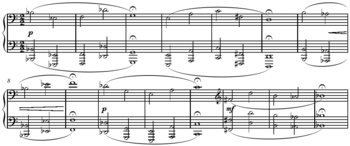
Back Twaalftoonmusiek Afrikaans Zwölftontechnik ALS طريقة الاثنتي عشرة نغمة Arabic Dodecafonismu AST Dodekafoniya Azerbaijani Додекафония Bulgarian Dodecafonisme Catalan Dodekafonie Czech Tolvtonemusik Danish Zwölftontechnik German

The twelve-tone technique—also known as dodecaphony, twelve-tone serialism, and (in British usage) twelve-note composition—is a method of musical composition first devised by Austrian composer Josef Matthias Hauer,[not verified in body] who published his "law of the twelve tones" in 1919. In 1923, Arnold Schoenberg (1874–1951) developed his own, better-known version of 12-tone technique, which became associated with the "Second Viennese School" composers, who were the primary users of the technique in the first decades of its existence. The technique is a means of ensuring that all 12 notes of the chromatic scale are sounded as often as one another in a piece of music while preventing the emphasis of any one note[3] through the use of tone rows, orderings of the 12 pitch classes. All 12 notes are thus given more or less equal importance, and the music avoids being in a key. Over time, the technique increased greatly in popularity and eventually became widely influential on 20th-century composers. Many important composers who had originally not subscribed to or actively opposed the technique, such as Aaron Copland and Igor Stravinsky,[clarification needed] eventually adopted it in their music.
Schoenberg himself described the system as a "Method of composing with twelve tones which are related only with one another".[4] It is commonly considered a form of serialism.
Schoenberg's fellow countryman and contemporary Hauer also developed a similar system using unordered hexachords or tropes—independent of Schoenberg's development of the twelve-tone technique. Other composers have created systematic use of the chromatic scale, but Schoenberg's method is considered to be most historically and aesthetically significant.[5]
© MMXXIII Rich X Search. We shall prevail. All rights reserved. Rich X Search


